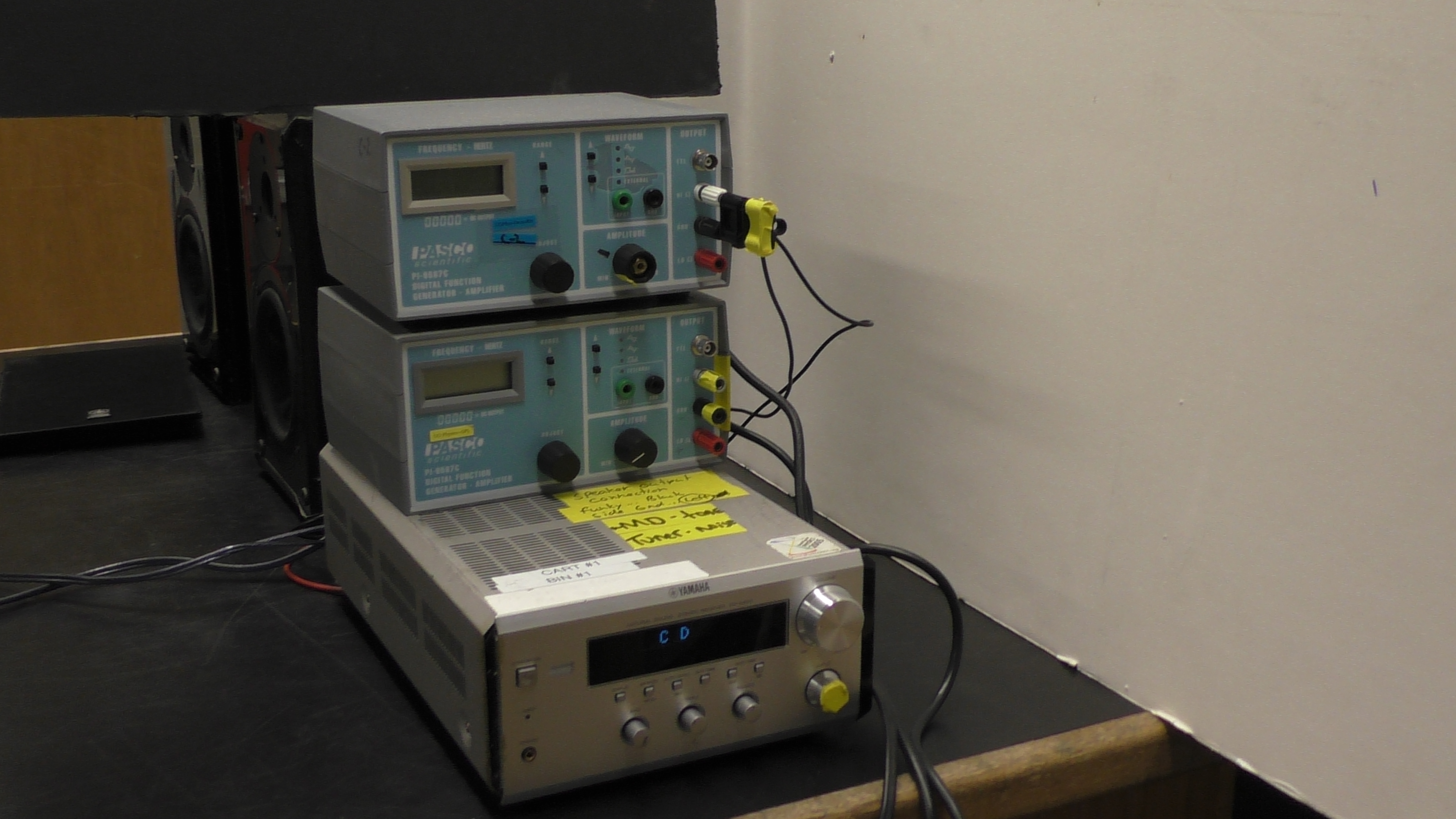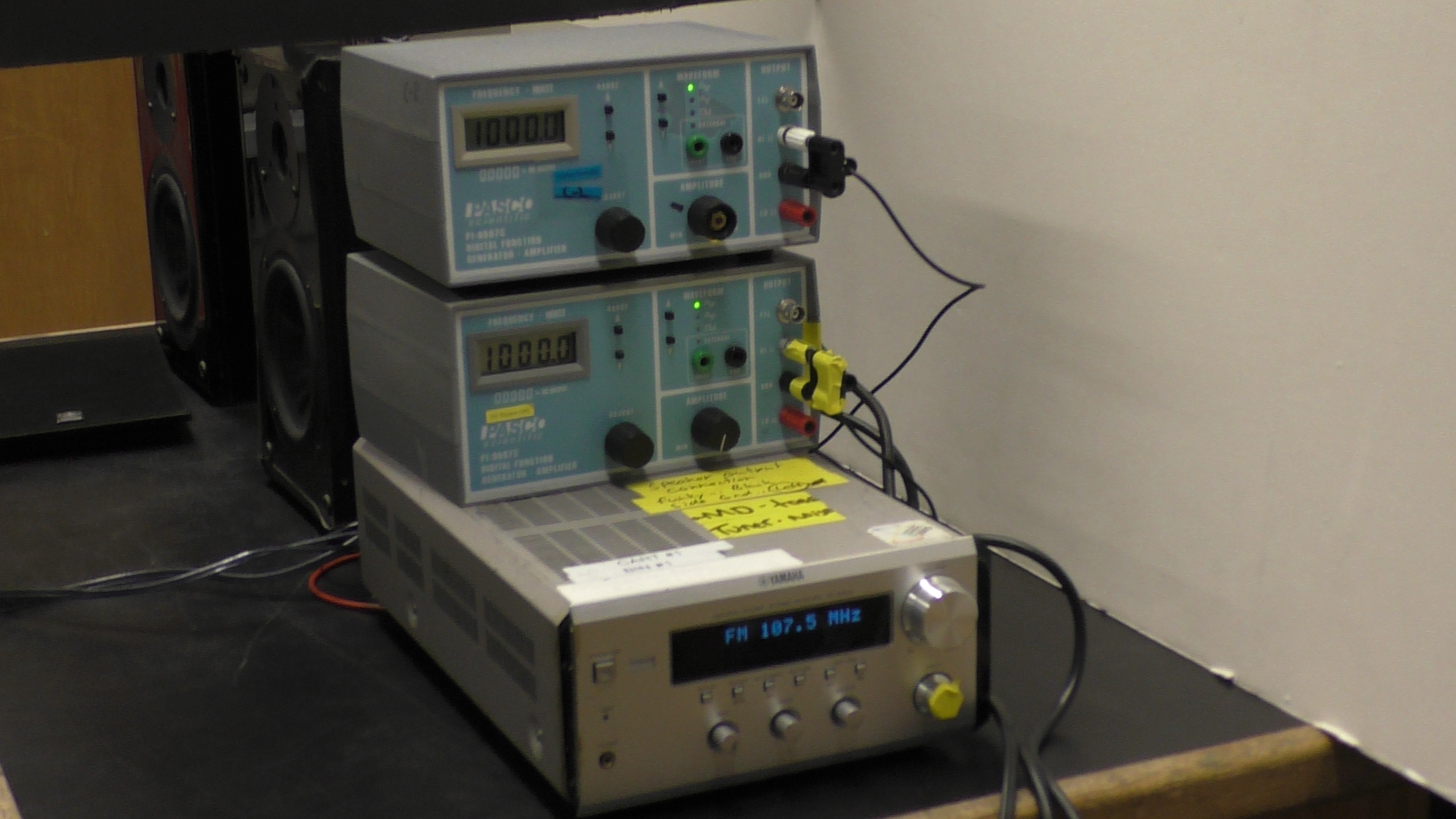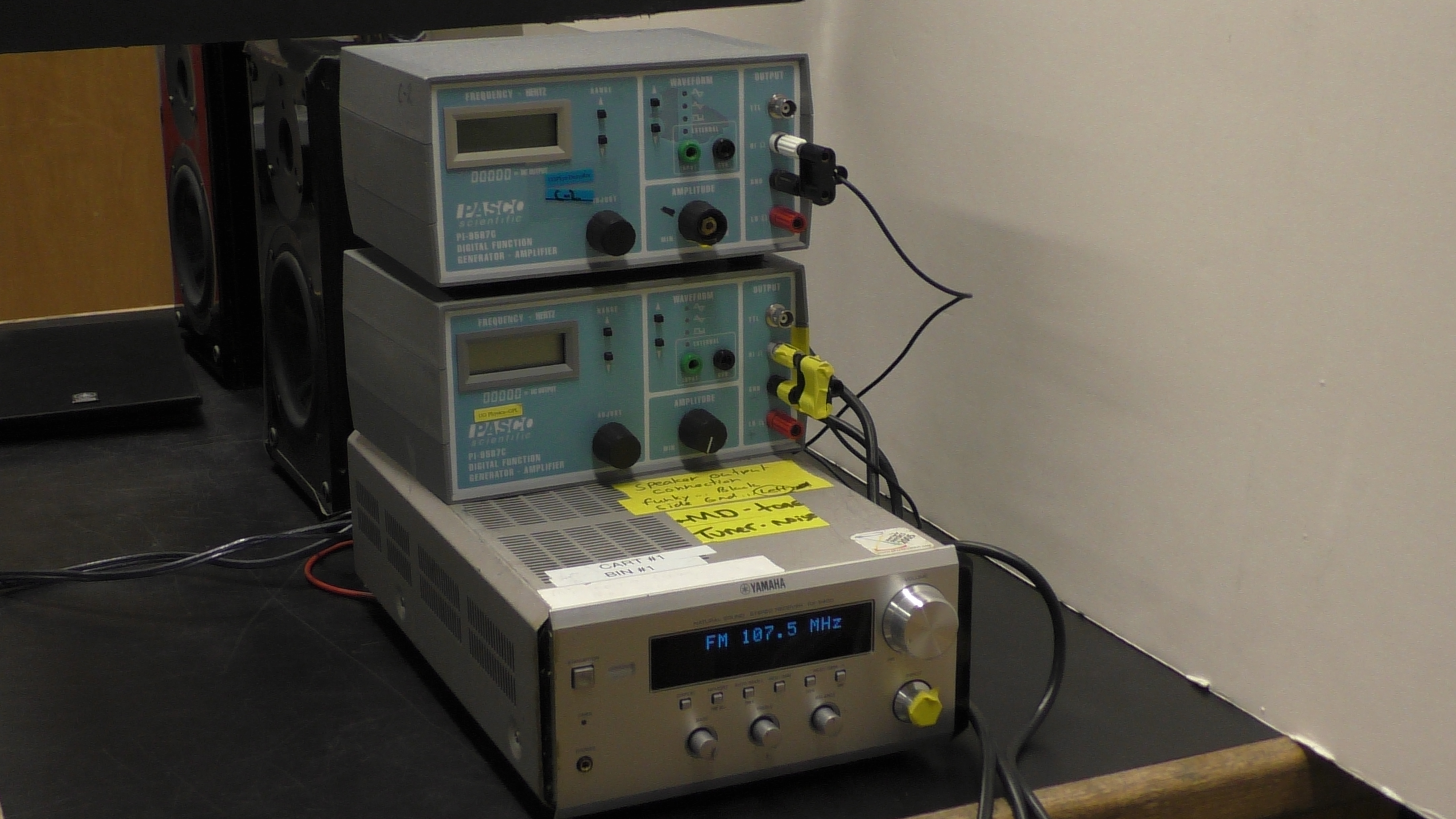Difference between revisions of "Interference--Stereo Speakers"
From UO Physics Demonstration Catalog
(Created page with "{{NewDemo|subject=OWS|topic=Waves|file1=Interference-Stereo Speaker.gif}} A common signal is sent to two speakers. One speaker is hooked through switch that changes the phase of one speaker by 180 degrees. At low frequencies, 50hz, students are asked in which position does the signal sound louder. Alternative: When two speakers wired out of phase are placed facing each other you will get substantial cancellation of sounds where the wavelengths are greater than the 3-4c...") |
|||
| (3 intermediate revisions by 2 users not shown) | |||
| Line 1: | Line 1: | ||
{{NewDemo|subject=OWS|topic=Waves| | {{NewDemo|subject=OWS|topic=Waves|file2=Interference front3.JPG|file3=Interference sig1.JPG|file4=Interference sig2.JPG|file5=Interference beats.JPG}} | ||
A common signal is sent to two speakers. One speaker is hooked through switch that changes the phase of | A common signal is sent to two speakers. One speaker is hooked through switch that flips the polarity on one speaker and thus changes the phase of the speaker by 180 degrees. If the speakers are separated by around 1 meter, the bass and low frequencies will be much lower in volume. At low frequencies, like 70hz, students are asked in which position does the signal sound louder. It is when the switch is set so the speakers are in phase. You can also show switching the wires on the back of the speaker is what changes the phase. | ||
Alternative: | '''Alternative 1''': Use a signal generator as your audio source. Separate and turn the speakers so they face the class and you should also be able to map out an interference pattern in the classroom by asking students to raise their hands when the bass coming from the speakers is the loudest, in position 1 or 2 (Out of Phase, in Phase). I would expect that you will get the center of the class raising their hands for the in phase position. Students off to the side may choose the out of phase position depending on how the sounds are bouncing around the room. This teaches the students why polarity needs to be observed when connecting speakers. Repeat with higher frequencies around 700 Hz. Have the students to plug one ear with a finger and then move their head form side to side. They should be able to hear the loudness of the sound vary as they mover their heads. | ||
'''Alternative 2 FUN SOUND EFFECT!''': Place the speakers facing each other and up against each other with no distance between them. Set the sound source to be white noise, the sound an FM radio receiver makes when off station. When the speaker switch is set to be out of phase, you will get substantial cancellation of the sound due to the phase difference. Flip the polarity switch so the speakers are in phase and the sound will be much louder, as we now have constructive interference between the two speakers. Again, flip the switch so the signals are out of phase and slowly separate the speakers. Slowly move one speaker away and you will first hear the frequency of a sound when the distance between the speaker is around ½ of a wavelength. SO you first hear high frequencies. The farther the separation, the lower frequencies will be heard. The effect sounds like a jet engine taking off. | |||
'''Alternative 3 Measurement:''' Place the speakers facing each other and up against each other with no distance between them. Use a signal generator as the sound source. Set the frequency to 430 Hertz with the speakers out of phase. Slowly separate the speakers and when the sound becomes the loudest, stop, and measure the distance between the speakers. It will be around 0.4m, ½ wavelength of the 430 Hz sound. | |||
Play some music with a lot of bass with the speakers separated around 1.5m and switch the phase switch. They will hear the dramatic effect on the bass and this is an example of why speakers being wired in phase is important. | |||
'''Location: | '''Location: | ||
* Speakers: Audio/speaker cart (by fume hood) | * Speakers: Audio/speaker cart (by fume hood) | ||
* Frequency Generator: Shelf C-2 | * Frequency Generator: Shelf C-2 | ||
* Amplifier: Audio/speaker cart (by fume hood) | * Amplifier with FM Tuner: Audio/speaker cart (by fume hood) | ||
*[https://physdemo.uoregon.edu/images/d/dc/Sound_Interference_wiring.pdf Wiring Instructions] | |||
Latest revision as of 12:14, 17 February 2023
Return to Waves
Description:
A common signal is sent to two speakers. One speaker is hooked through switch that flips the polarity on one speaker and thus changes the phase of the speaker by 180 degrees. If the speakers are separated by around 1 meter, the bass and low frequencies will be much lower in volume. At low frequencies, like 70hz, students are asked in which position does the signal sound louder. It is when the switch is set so the speakers are in phase. You can also show switching the wires on the back of the speaker is what changes the phase.
Alternative 1: Use a signal generator as your audio source. Separate and turn the speakers so they face the class and you should also be able to map out an interference pattern in the classroom by asking students to raise their hands when the bass coming from the speakers is the loudest, in position 1 or 2 (Out of Phase, in Phase). I would expect that you will get the center of the class raising their hands for the in phase position. Students off to the side may choose the out of phase position depending on how the sounds are bouncing around the room. This teaches the students why polarity needs to be observed when connecting speakers. Repeat with higher frequencies around 700 Hz. Have the students to plug one ear with a finger and then move their head form side to side. They should be able to hear the loudness of the sound vary as they mover their heads.
Alternative 2 FUN SOUND EFFECT!: Place the speakers facing each other and up against each other with no distance between them. Set the sound source to be white noise, the sound an FM radio receiver makes when off station. When the speaker switch is set to be out of phase, you will get substantial cancellation of the sound due to the phase difference. Flip the polarity switch so the speakers are in phase and the sound will be much louder, as we now have constructive interference between the two speakers. Again, flip the switch so the signals are out of phase and slowly separate the speakers. Slowly move one speaker away and you will first hear the frequency of a sound when the distance between the speaker is around ½ of a wavelength. SO you first hear high frequencies. The farther the separation, the lower frequencies will be heard. The effect sounds like a jet engine taking off.
Alternative 3 Measurement: Place the speakers facing each other and up against each other with no distance between them. Use a signal generator as the sound source. Set the frequency to 430 Hertz with the speakers out of phase. Slowly separate the speakers and when the sound becomes the loudest, stop, and measure the distance between the speakers. It will be around 0.4m, ½ wavelength of the 430 Hz sound.
Play some music with a lot of bass with the speakers separated around 1.5m and switch the phase switch. They will hear the dramatic effect on the bass and this is an example of why speakers being wired in phase is important.
Location:
- Speakers: Audio/speaker cart (by fume hood)
- Frequency Generator: Shelf C-2
- Amplifier with FM Tuner: Audio/speaker cart (by fume hood)
- Wiring Instructions



